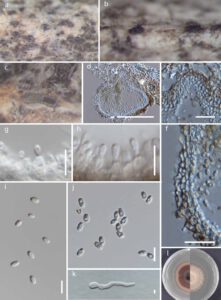Neoroussoella peltophori Pasouvang P & K.D. Hyde (FIGURE 1)
Index Fungorum number: IF558564; Faces of fungi number: FoF 09995
Etymology: –The specific epithet reflects the generic name of the host Peltophorum vogelianum(Fabaceae).
Holotype: – MFLU 21-0113
Saprobic on dead twigs of Peltophorum dasyrhachis. Sexual morph: undetermined. Asexual morph: Coelomycetous. Conidiomata 166–224 µm diam × 141–178 µm high (¯(x )= 195 × 159 µm, n = 2), scattered to gregarious, erumpent, globose to sub-globose, coriaceous dark brown to black, surrounded by dark brown parenchymatous cells. Ostiole papillate, central, circular. Conidiomata wall 9–12 µm wide, composed of thick-walled, dark brown cells of textura angularis; inner layer thin, hyaline. Conidiophores usually reduced to conidiogenous cells. Conidiogenous cells 1–3.5 × 6.5–8 µm (¯x = 2.2 × 7.2 µm, n = 4), phialidic, ampulliform to cylindrical, hyaline, smooth-walled. Conidia 1.7–2.7 × 3–4.2 μm (¯x = 1.9 × 3.7 μm, n = 26), initially hyaline, becoming pale brown when mature, oblong to ovoid, straight, both ends broadly rounded, aseptate with two guttules, smooth-walled.
FIGURE 1 Neoroussoella peltophori (MFLU 21-0113, holotype). a–c Conidiomata on Peltophorum dasyrhachis. d Section through conidioma. e Section through ostiole. f Section of conidioma wall. g, h Conidiogenous cells and conidia. i, j Conidia. k Germinating spore on PDA. l Culture characteristics on PDA. Scale bars: d = 100 µm, e= 20, f = 20 µm, g-h = 10 µm. i-j = 5 µm. k = 3 µm.

